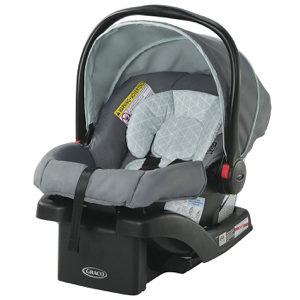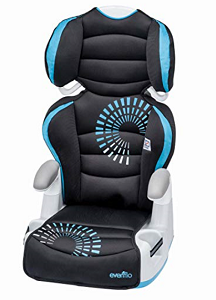How Long Are Car Seats Good for Before They Expire?

What is the lifespan of a car seat?
The lifespan of a car seat varies both by brand and type of car seat. Rear-facing seats, the kind you use to bring your infant home from the hospital, have shorter shelf lives while convertible and booster seats last a bit longer. So while a rear-facing Evenflo car seat will last you six years, a booster seat from Chicco will last closer to eight.
When to upgrade your car seat
Rear-facing car seats
- Usually last about six years
- Fit infants and toddlers up to 35 lbs. and 32 in. tall
Convertible seats
- Last between six and 10 years
- Fit kids up to 60 lbs. and 50 in. tall
Booster seats
- Last between six and 10 years
- Fit children up to 100 lbs. and 57 in. tall
How long do infant car seats last?
Rear-facing car seats typically last for six years. Infants and toddlers should use a rear-facing seat until they reach the maximum height or weight limit—usually around 40 pounds and 32 inches respectively—which varies by brand.1
How long do booster seats last?
Backless and belt-positioning booster seats last for about 10 years. Use one if your child is 40–57 inches tall or 40–100 pounds.
Do car seats actually expire?
In short, yes. To figure out when a car seat expires, reference the seat’s owner’s manual for its lifespan and find the manufacturer’s label on either the side or base. Some seats have the date of manufacture, others list an actual expiration date, and some car seats have both.
If you no longer have your owner’s manual on hand or if you don’t remember when it expires, don’t worry. You can write down the seat’s model number and look up the lifespan online on the brand’s website or call the manufacturer to find out when your car seat expires.
Why do car seats expire?
Car seats expire for several reasons:
- Wear and tear
- Improved standards
- Replacements and recalls
Car seats are typically made of plastic, which degrades over time, especially when exposed to extreme temperatures. And since these child restraints stay inside your vehicle, they’re often exposed to both very warm and very cold temperatures. Depending on where you live, the temperature inside your vehicle can range from -50°F to 140°F.2
For an easy comparison, consider what a plastic patio set looks like after being exposed to sun, heat, and cold temperatures year after year. It’s brittle and prone to breaking. The same goes for your car seat, which holds much more precious cargo.
Technology is constantly improving and so are car seats. A seven-year-old convertible seat may look like it’s in good condition but it won’t be fit with the latest technology—like energy-absorbing foam or steel frames—to save your child’s life in a crash.
If you’re curious about technology’s role in car seats, consider the LATCH system. LATCH, an advanced technology that makes it easier to install and secure car seats, is required on car seats and most vehicles, but it wasn’t standard until 2002.3
It’s good practice to register your car seat with its manufacturer after your purchase so you can keep up with any recalls. If you’re using a used or expired seat, you risk that it may have been part of a recall that you don’t know about.
Plus, parts are bound to go missing when you’re converting your 3-in-1 car seat from rear-facing to forward-facing to a booster. If your car seat is creeping towards its expiration date, you may not be able to get replacement parts after that date has come and gone.
Can you reuse a car seat?
If your child has outgrown their car seat but the seat is in good condition with all parts intact, hasn’t expired, and hasn’t been recalled, you can reuse it or pass it on. But if the seat is damaged in any way or if it’s been in a car accident, don’t reuse it.
We also recommend to avoid purchasing used seats online. You have no way of knowing if the seat was involved in a severe crash or if any parts are missing.
If you’re looking for something to do with an expired or damaged seat, you have a few options.
What to do with an expired car seat
Tempting though it may be to let an expired or damaged car seat collect dust in your garage or to dump it on the corner for sanitation to deal with, there are other options.
Stores like Target and Walmart offer annual trade-in events where you can swap an old car seat for a coupon or gift card. And although most recycling centers don’t accept car seats, you can check recycleyourcarseat.org to see if any recycling locations in your state accept car seats.
If you opt to throw it out, there are a few steps you should take to make sure someone else doesn’t get their hands on an unsafe seat:4
- Use scissors to cut off the seat’s fabric, foam padding, and safety or harness straps.
- Use a screwdriver to remove as much metal as you can. Afterwards, remove the car seat cover and any padding underneath.
- Throw away unrecyclable bits like fabric, straps, and small plastic or metal pieces.
- Use a permanent marker to mark the remaining plastic unsafe and cross out the expiration date.
- Recycle the plastic body of the car seat and any remaining metal parts.
Conclusion
While car seats can last anywhere between six and 10 years, it’s important to retire them once they’re expired to ensure your children’s safety. We recommend keeping up with your child safety seat’s expiration date—and replacing as needed—to keep your little ones safe.
Sources:
- American Academy of Pediatrics, “AAP Updates Recommendations on Car Seats for Children”
- The Washington Post, “Yes car seats expire and here’s why”
- National Highway Traffic Safety Administration, “Lower Anchors and Tethers for Children (LATCH) Restraint System”
- Consumer Reports, “What to do with a used car seat, do they expire?”
Product prices and availability are accurate as of the date/time indicated and are subject to change. Any price and availability information displayed on relevant Amazon site(s), as applicable, at the time of purchase will apply to the purchase of this product.
Certain content that appears on this site comes from Amazon. This content is provided “as-is” and is subject to change or removal at any time.









